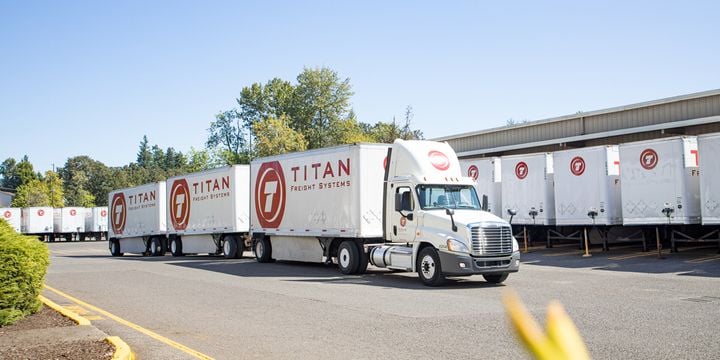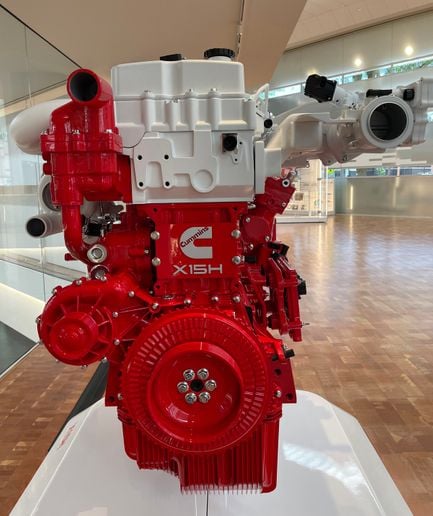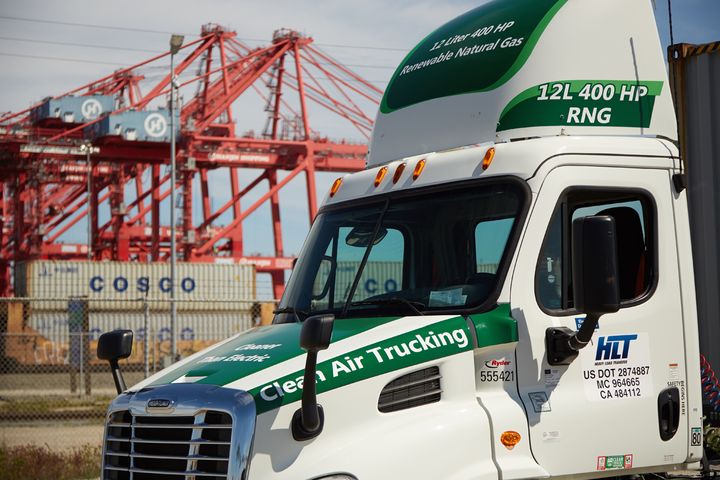Trucker Access › Forums › Diesel News › HDT’s 2022 Newsmaker of the Year: The Internal Combustion Engine – Fuel Smarts
- This topic has 0 replies, 1 voice, and was last updated 10 months, 3 weeks ago by
 EazyRiDer66.
EazyRiDer66.
-
AuthorPosts
-
May 14, 2024 at 5:45 am #20413
 EazyRiDer66Keymaster
EazyRiDer66Keymaster

Titan Freight Systems, a regional less-than-truckload carrier in the Pacific Northwest, found renewable diesel was key to meeting its emissions goals — even as it prepares for battery-electric truck deliveries in 2023.
Even as governments continue to push for the transition to zero-emission trucking, work continues on making internal combustion engines greener than ever. The news this year was full of the latest ICE developments, making the internal combustion engine HDT’s 2022 Newsmaker of the Year.
As Srikanth Padmanabhan, president of Cummins’ engine business, said in announcing the company’s “fuel-agnostic” engine platform, “getting to zero is not a light-switch event.
“Carbon emissions that we put into the atmosphere today cannot be taken back. This means anything we can do to start reducing the carbon footprint today is a win for the planet.
“We know our planet cannot wait for the perfect solution.”
Renewable natural gas and renewable diesel are already available in some areas that can be used in existing CNG and diesel engines. And in the coming years, the industry will see more alternative-fuel options for internal combustion engines, as well as ever-cleaner diesel engines, even hybrids.
Greener Fuels for Trucking
The wave of news started in January, when Werner Enterprises and Cummins announced the fleet would begin validation and integration of Cummins’ 15L natural gas and 15L hydrogen internal combustion engines in its heavy-duty trucks.

Cummins announced it will offer an internal-combustion engine that will be fueled with hydrogen.
Cummins elaborated a couple of weeks later, announcing its new engine program.
The company’s B, L and X-Series engine portfolios for medium- and heavy-duty vehicles will see the addition of versions that operate on fuels such as gasoline, natural gas, hydrogen and propane. They will use engine blocks and core components that share common architectures but will be optimized for different low-carbon fuel types. Each engine version will operate using a different, single fuel.
At ACT Expo in California in May, Cummins unveiled a 15L hydrogen engine that is expected to go into full production in 2027. Hydrogen internal combustion engines can use zero-carbon fuel at a lower initial price than a fuel-cell or battery-electric vehicle with little modification to today’s vehicles, according to the company.
A few months later, Westport announced it had developed a new fuel system that can burn hydrogen in heavy-duty IC truck engines.
The H2 HPDI fuel system is based on Westport’s HPDI (high-pressure direct injection) technology. HPDI allows heavy-duty trucks to run on biomethane (renewable natural gas) or natural gas with the same power, torque, efficiency and performance as diesel engines, according to the company. Westport officials said the company has achieved even better results by adapting the HPDI fuel system to run on hydrogen.
The H2 HPDI fuel system offers a cost-effective zero-carbon solution, Westport officials said, delivering, tank to tailpipe, up to a 98% CO2 reduction over diesel.
When using Westport’s hydrogen HPDI technology applied to a Scania 13L CBE1 engine platform, early test results show a peak brake thermal efficiency of nearly 52%, with engine-out nitrogen oxides similar to the base diesel engine, which is compatible with Euro VII on-highway and EPA 2027 emissions standards.
If you were an editor of HDT, which of these would you vote as the biggest trucking topic of 2022?
— Heavy Duty Trucking (@HDTrucking) December 22, 2022
Another approach we saw this year was ClearFlame’s engine modification technology, which allows existing heavy-duty engines to run on a range of renewable fuels in place of diesel fuel. Through better thermal management, ClearFlame’s technology enables these alternative liquid fuels to behave like diesel fuel, with no loss of efficiency or power, according to the company. For their first trucks, they’ve chosen ethanol based on its lower emissions, lower cost and widespread availability.
Hybrid powertrains are offering a way to combine some of these cleaner fuels with battery-electric operation.
Hyllion, which has been working on hybrid drive systems with several OEMs, including Daimler Truck North America, inked a deal with Cummins to optimize its natural gas engine as the generator for the Hypertruck ERX powertrain.
The Hyliion Hypertruck ERX is an electric range extender semi-truck powertrain solution using onboard power generation to recharge the batteries. The system offers 75 miles of electric range to qualify for credits under the California Air Resource Board’s upcoming ZEV mandates and can achieve up to 1,000 miles of full range through the generator.
And at ACT Expo, U.S. Hybrid launched a near-zero-emission natural gas-powered parallel hybrid powertrain technology to be used for drayage and long-haul trucks. It offers 640 hp combined power and 1770 lb-ft maximum torque from the natural gas-powered engine. The electric motor enables uphill acceleration.
Greener Fuels, Cleaner Diesels
Renewable natural gas and renewable diesel are more sustainable versions of fuels already used in engines, offering emissions reduction without changing the engine.
Low-carbon renewable diesel and biodiesel fuels are delivering significant greenhouse gas and other emissions reductions in California, and hold expanded opportunities for reducing carbon emissions from the trucking sector in Connecticut, Massachusetts, New York, New Jersey, and six other Northeastern states, according to the Diesel Technology Forum.
A recent study evaluating options for commercial truck fleets in the Northeast found that compared to a full electrification strategy, between now and 2032, three times the reduction in carbon dioxide emissions can be achieved at 25% of the cost by accelerating the turnover of older trucks to new advanced technology diesel models and using low-carbon renewable biodiesel fuels across the entire fleet.

Renewable natural gas allows fleets to meet cleaner-air and GHG goals even while working on a transition to zero emissions, such as at the southern California ports.
At the same time, diesel engines are getting more fuel-efficient for a lower carbon footprint as well as meeting ever-stricter tailpipe emissions standards.
The Environmental Protection Agency’s SuperTruck II program is helping truck and engine makers try out new technology to improve freight efficiency and fuel economy. Peterbilt showed off the tractor of its SuperTruck II project recently, and DTNA plans to unveil its project early in 2023.
Recently we learned Jacobs Vehicle Systems, leaning on its experience with variable valve actuation, has developed an in-cylinder solution that promises drastic cuts in NOx along with more modest improvements in fuel efficiency.
Then there’s the opposed-piston engine. This year, several organizations, companies, research labs, and academia, formed the Hydrogen Opposed Piston Engine Working Group, a collaborative forum to advance sustainable transportation technology. That includes Achates Power, which has been working with leading engine manufacturers to bring the opposed piston engine to market.
Achates’ 10.6L, 2-stroke, 3-cylinder, opposed-piston engine already meets 2027 emissions regulations while being lighter and a claimed 30% more fuel-efficient compared to an equivalent conventional diesel.
Welcome to the ‘Messy Middle’
There is “an unprecedented mix” of new powertrain technologies already on the commercial vehicle market, said Uma Vajapeyazula, director of Cummins’ engine business on-highway product strategy, during a press event over the summer.
“We are fast approaching a period [Mike Roeth, the executive director of the North American Council of Freight Efficiency] calls ‘the messy middle’ — a period where some technologies come to market before others. With in this environment, fleets will experiment with several different alternative-fuel or zero-emissions powertrains in an effort to discover which technology works well for its particular applications. Moreover, this could very well mean that fleets may have to simultaneously adopt several different powertrain technologies to support different applications in different geographic regions.”
This article appeared in the November/December 2022 issue of Heavy Duty Trucking.
-
AuthorPosts
- You must be logged in to reply to this topic.